As an Amazon Associate I earn from qualifying purchases.
Yes, you can eat acorns, and all acorns are edible — it’s just that most need special processing. Here’s how to go about it.
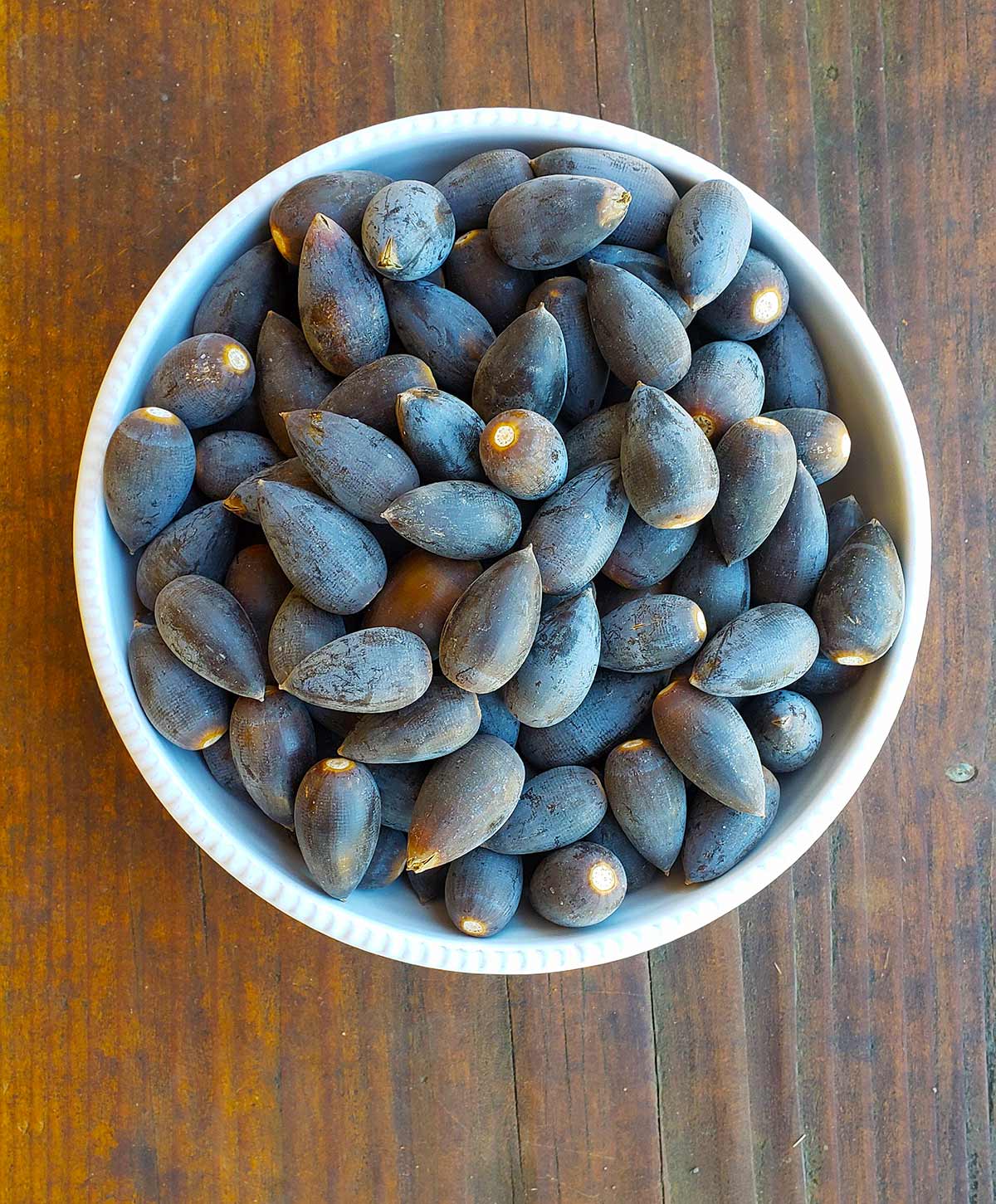
If you haven’t read my other acorn posts, Acorns and the Forager’s Dilemma is an introduction to the use of acorns; the Forager’s Dilemma is, in a word, starch. Starch (carbohydrates) is the toughest thing to gather, and is a primary reason why humans settled down 10,000 years ago to grow grain.
Next I wrote about how various world cultures have traditionally used acorns, cultures ranging from Korea to Japan to the Native Americans, Europeans and North Africans.
Let me say loud and clear that you can eat acorns and all acorns are edible, at least all species of acorns are. We’ll get into details in a bit.
Basically there are three ways to eat acorns: Eating them as nuts (they are a lot like chestnuts), making acorn flour, or cooking in acorn oil. I have not yet tried to make acorn oil, but that link leads you to my friend Sam Thayer’s website; he sells it.
Collecting Edible Acorns
First you need to get yourself a supply of acorns. Go find some oak trees; they’re the ones with all the acorns that have fallen down around them. I know this sounds condescending and stupid, but oaks come in so many varieties that in autumn this really is the easiest way. It is a bit of a crapshoot, as it is tougher to determine a variety of oak by its acorn than by its the leaf — you can do it, but it is a little harder.
You can gather acorns anytime from September until early spring. I find gathering as the acorns fall is best. Suellen Ocean, who wrote a very useful book Acorns and Eat ’em,says she likes to collect Tanoak acorns in February and March, after many have begun sprouting.
She says acorns with sprouts between 1 to 2 inches long are still good to eat, but discard any acorn meats that have turned green. Ocean says recently sprouted acorns a) have begun to turn their starch into sugar, and b) are foolproof: “If it is sprouted, it’s a good acorn and I haven’t wasted time gathering wormy ones.”
A word on worms. When I first gathered acorns, little did I know that I had gathered scores already infected with the larva of the oak weevil. Nasty little maggoty things, you can tell they are inside your acorn if there is a little hole in the shell. Look for it, discard that acorn and move on. But know that oak weevil larvae bored those holes from the inside out. Like Alien.
It’s helpful to know what kind of oak you are dealing with because acorns from different oaks have different levels of tannins in them; more on that in a bit. If you don’t know your trees, start looking for little green acorns in May. Pick a leaf and compare it to oak leaves online or in a guidebook. Gather acorns and compare them to online images and guidebooks; different oaks bear acorns with different shapes.
With that in mind, remember that not all oaks are created equal, and the fundamental fact to know if you are going to eat acorns is that you are dealing with a wild food, and as such must contend with tremendous variability, both in species and even among individuals of the same species.
Some oaks bear acorns so low in bitter tannins that they can be eaten raw. Legend says that California Indians fought over these trees, which makes some sense because one mature Valley Oak can drop 2,000 pounds of acorns in a really good year. A ton of sweet acorns may well be worth fighting over.
That said, even “sweet” acorns should be leached to remove what tannins exist in them because several studies show that unleached acorns can make you constipated and can harm your teeth. Of all the species I know of, only the imported European cork oak and the Emory oak of the Sonoran Desert come close to being “sweet.”
Tannins aren’t the only thing that makes different species of acorn different. UC Riverside Professor David Bainbridge wrote in a 1986 academic paper that depending on species, acorns can range in fat content from 1.1 percent to 31.3 percent, protein from 2.3 percent to 8.6 percent, and carbohydrates from 32.7 percent to 89.7 percent. That is a huge range!
What does it mean? It means that in the kitchen you treat acorns from different species very, very differently. A fatty acorn will make a meal, like ground almonds. A carb-rich acorn — like Valley Oak acorns — makes a drier flour, more like chestnut or chickpea flour (acorns lack gluten and so will not rise.)
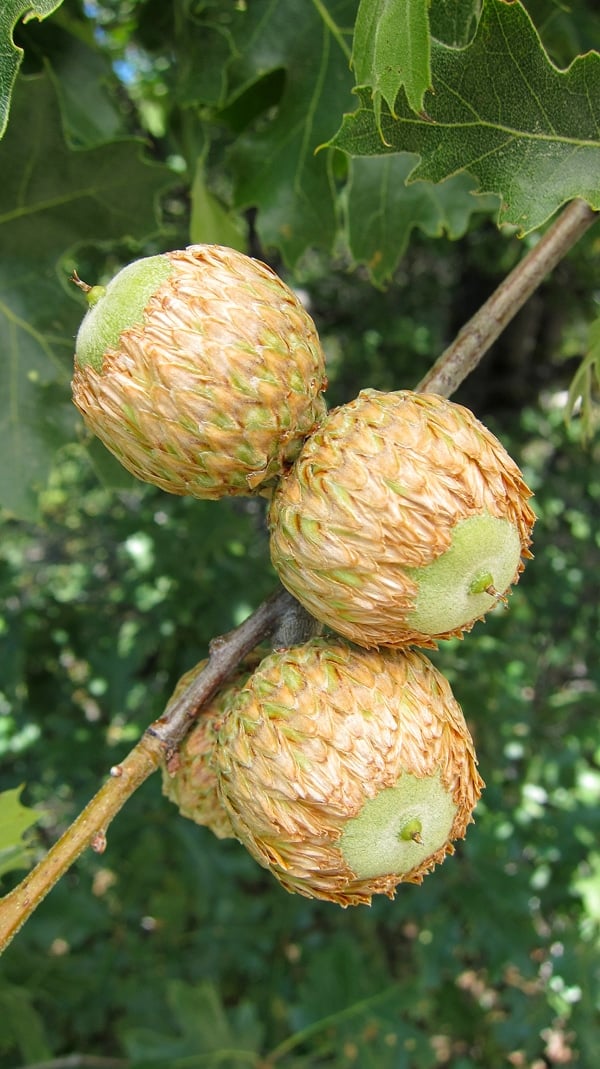
Differences in Various Oaks
Here’s a general breakdown:
‘Sweetest’ Acorns, meaning lowest in tannin: East Coast white oak, the Emory oak of the Southwest, the pin oak of the South, the valley and blue oaks of California, the burr oak of the Midwest, as well as the cork oak and the well-named bellota oak of Europe. To my California readers, know that there are an awful lot of cork oaks and burr oaks planted in towns and cities here, so keep your eyes peeled.
Largest Acorns: Valley oaks are really big, as are East Coast White oaks. Burr oaks are large, too, as is the California Black oak.
Fattiest Acorns: The Eastern red oak acorns I’ve used have a very high oil content, and I’ve read that the Algonquin used red oak acorns for oil. In the West, the champions are both live oaks, the Coastal and the interior live oak, as well as the tanoak and black oak, which is Quercus kellogii.
Shelling Acorns
I found that shelling the acorns is the most onerous part of dealing with them. They have an elastic shell that resists normal nut crackers. I found whacking them with a hammer to be the best way to open up an acorn. Some people use a knife, and I do this with green acorns, but not fully ripe ones.
Best way to whack ’em is to put the flat end (the side that used to have the cap) on a firm surface and rap the pointy end with a hammer, or, with long, tapered acorns like cork oak or Valley oaks, just whack the side.
Acorns are far easier to shell after they’ve dried. If you choose to dry them, do this in wide, shallow pans so they don’t get moldy. Once dried, I’ve worked with two-year-old acorns and they were fine. They will need an overnight soak before grinding, however.
Red oak acorns have a “test,” a skin that doesn’t want to come off, just like a chestnut. Easiest way to deal with this is to freeze your fresh acorns for a week or two before cracking. This will slip the skin off the nut. The skin is bitter, but it’s not that big a deal if you are making flour.
Shell your acorns into water. The meats oxidize, and you will get a lighter-colored flour if you do this. It’s aesthetic, but it matters to me.
Tannins
All acorns should be leached with water to remove bitter tannins, which will a) make your mouth feel and taste like felt, b) make you a bit nauseous, and possibly c) constipate you for days.
Getting those tannins out is the big barrier to cooking with acorns. But it ain’t no biggie. With my valley oak acorns, after shelling I drop the acorn meats directly into my stockpot that was two-thirds full of water. When I fill the pot about a third of the way up with shelled acorns, if I am in a hurry, I bring the pot of water to a boil. The water turns dark. As soon as it boils, pour the water off into the sink and repeat the process.
It requires about five changes of water to get valley oak acorns to taste like chestnuts. I did this all while watching football, and did not miss a snap. Other oaks will require more or fewer changes of water. Choose the “sweetest” acorns on my list above for the least amount of work.
There is a better method, but it takes days. Grind the raw acorns into flour, then mix a ratio of 1 cup of acorn meal to 3 cups water, or more water if you have large containers. Pour this all into a glass jar with a lid and put it in the fridge. Every day you shake the jar, wait 12 hours or more, then pour off the water — and the tannins.
How long? Anywhere from a week to two weeks, depending on how bitter your acorns are. This is a good way to leach acorns without using fuel for boiling water, and you do not denature a particular starch in the acorns that acts a little like the gluten in flour, i.e., it helps the flour stick to itself. I go into the full process of cold leaching acorns here.
If you plan on baking with the acorn flour, use the cold-water leaching method.
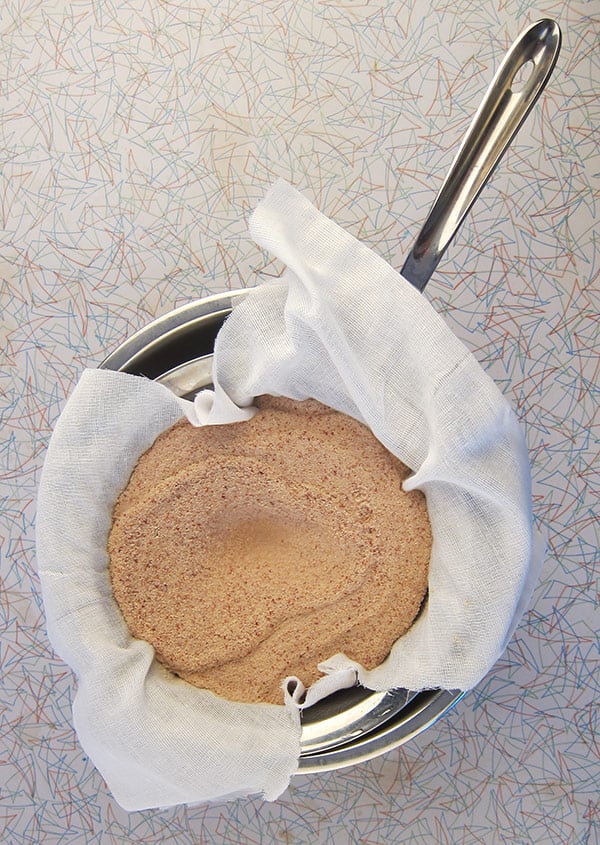
Once your acorns are free of tannins, you need to figure out what to do with them. Regardless, you need to dry them first or they will rot. Acorn grits can be patted dry on a tea towel. If it is hot out, lay the acorns out on cookie sheets and dry in the shade. You could also put them in an oven set on “warm.” You can also put the acorns in a dehydrator set on low heat, which is what I do.
You can also freeze your fresh acorn meal. Store dried flour in jars in the fridge. Why the fridge? What fat there is in acorns will go rancid pretty quick if you left the flour at room temperature.
What you can now do to eat acorns is pretty limitless.
My first success was an acorn flour flatbread in the style of an Italian piadina. I also make an acorn flour honey cake, which is really very tasty — almost like gingerbread cake. The flour also makes an excellent pasta dough when mixed with regular flour.
Other Ways To Eat Acorns
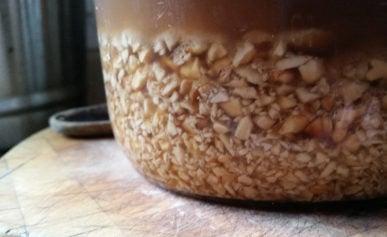
Acorn Grits
Acorn grits, which are useful additions to acorn soup, acorn muffins or to eat as a breakfast cereal.
Read More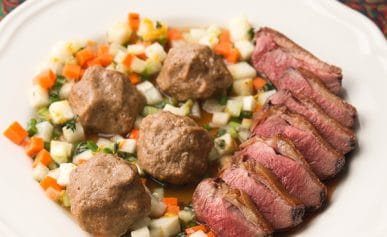
Wood Duck and Acorn Dumplings
Acorn dumplings, served with wood duck — wood ducks eat acorns, so it seemed fitting.
Read More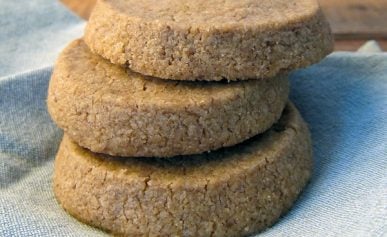
Acorn Maple Shortbread Cookies
Acorn cookies, more or less like shortbread. A bit tricky to make, but even if they fall, they are still delicious.
Read More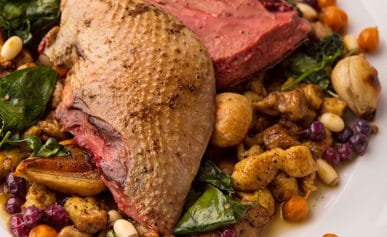
Acorn Spätzle
Acorn spätzle, little German dumplings that work very well with gluten free acorn flour.
Read MoreI will also substitute about 1/5 of the flour in my homemade flour tortillas with acorn flour, and I also make mean acorn gnocchi.
Use your imagination!

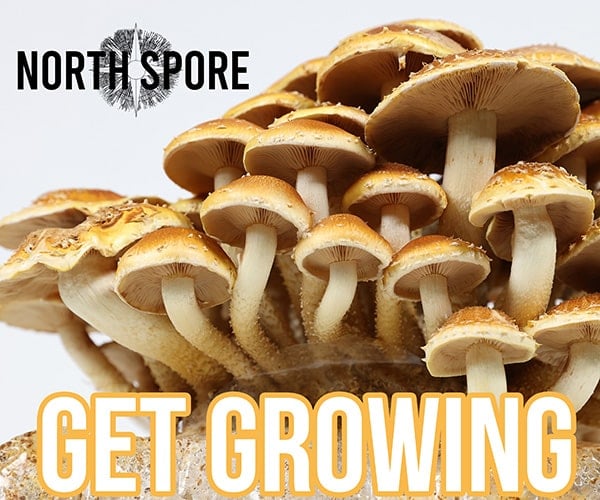



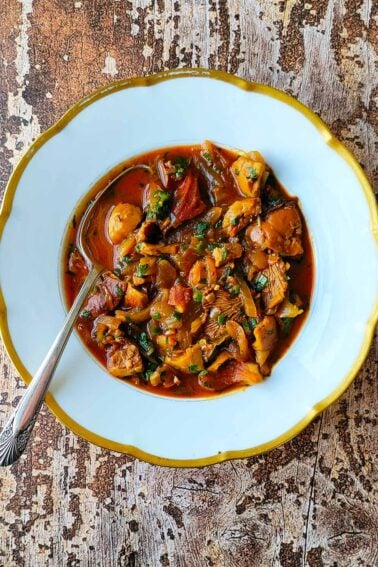

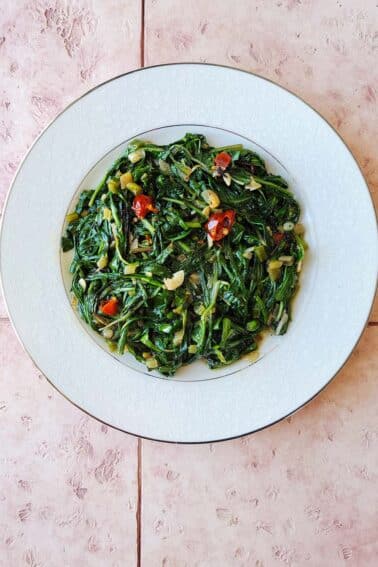
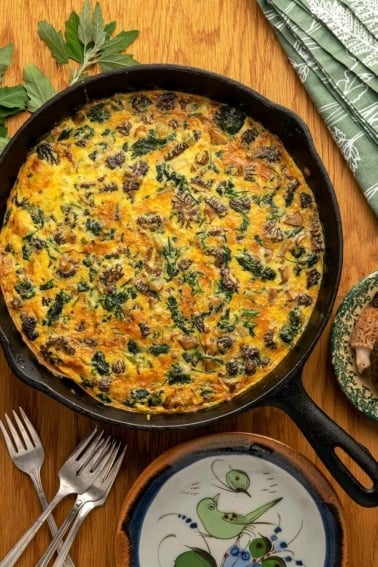
WOW, NOW IM LOOKING FOR OAK TREES1 HOPE I CAN FORWARD THIS WONDEROUS KNOWLEGE TO MY GRANDKIDS, JUST IN CASE– YOU KNOW FOR SURVIVLE, NEVER KNOW WHAT THEFURURE CAN BRING TO OUR DOOR
Good day Sir. I have tried harvesting the acorns from my yard twice this season. First batch was collected shortly after dropping and then shelled. Meats were a fine looking yellowish color, while some had black veins running through them. After shelling they were collected in a tub where I was going to start the cold leach process. They had all turned very dark brown and mostly black. I abandoned the project thinking I may have gathered the first drop or got a bad batch in some other way.
Second attempt was similar. Gathered quickly after dropping, but this time I left them to dry in the shell in the sun for several weeks as I had read they store quite well in this way. Cracked them open this afternoon and every single one is mostly black, with only a few having the pleasing yellow color. It does not appear to be a mold. I do not know the species, but we are at the northern end of the San Gabriel Mtns and even the scrub oak are prolific this year. I will be trying once more this year by finding them still on the tree and shelling immediately. If you have any ideas about the color of the meats, it would be greatly appreciated. I have not been able to get a clear answer, in all my searching, as to whether it’s ok to process the darkened meets, or as to why they are so discolored. The percentage of “spoiled?” meats is well over 90%. Thank you for your time.
Jason: That black is normally the presence of the weevil larva in the acorn. I’d make sure to gather none with holes, and none that float. Good acorns sink. Also, acorn meats oxidize and darken if left out fresh, so that’s what might have happened in the first batch. I shell them right into water, buzz them and make the flour all in one go.
I’ve had the same exerience as Jason. Gathered acorn soon after dropping and left them on a pan in the sun by a window for weeks. All of them looked perfect. No holes, no mold and all sinking when washed. As I’m now opening the acorns every single one is black (dark brown) but otherwise they look and feel just fine – and I don’t know if I can use them or not? Can you assist?
Lotte: Cut them in half. Sometimes it’s only on the surface.
So you know about California bay nuts? They are bitter but fine once roasted. The tree is in the coastal mts and Sierra. A tree can have a prolific crop.
The Koreans (and Japanese I believe) make acorn starch as another alternative use. (It is different than the flour in that it gels, translucent, rather then makes a crumb like regular flour.
This starch can be made into a savory jelly that can be used as a base for savory dishes w/green onions, soy, ginger, etc.
I like this recipe: https://www.maangchi.com/recipe/dotorimuk-muchim